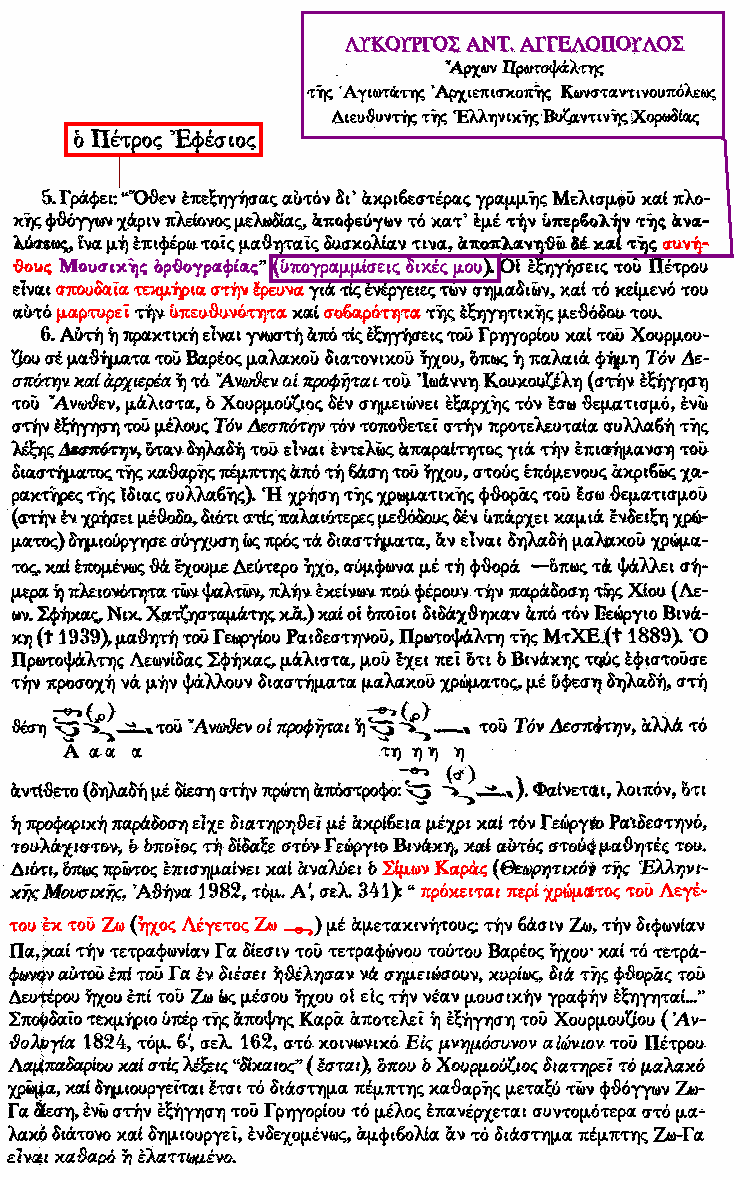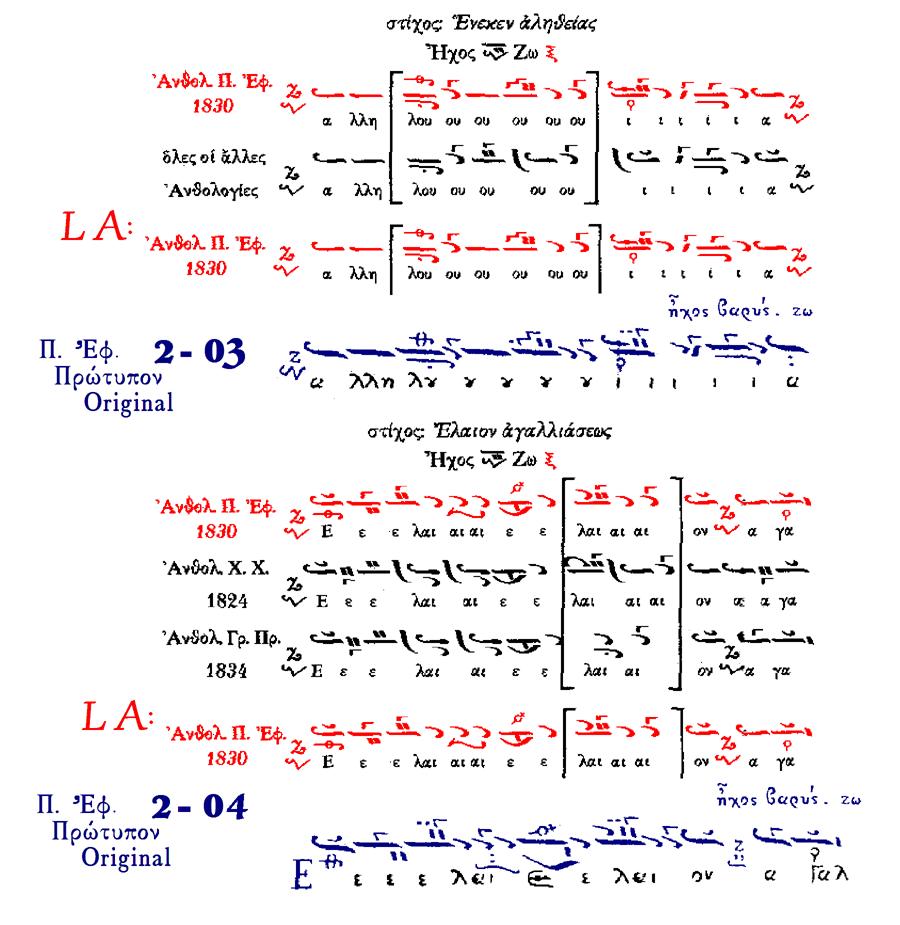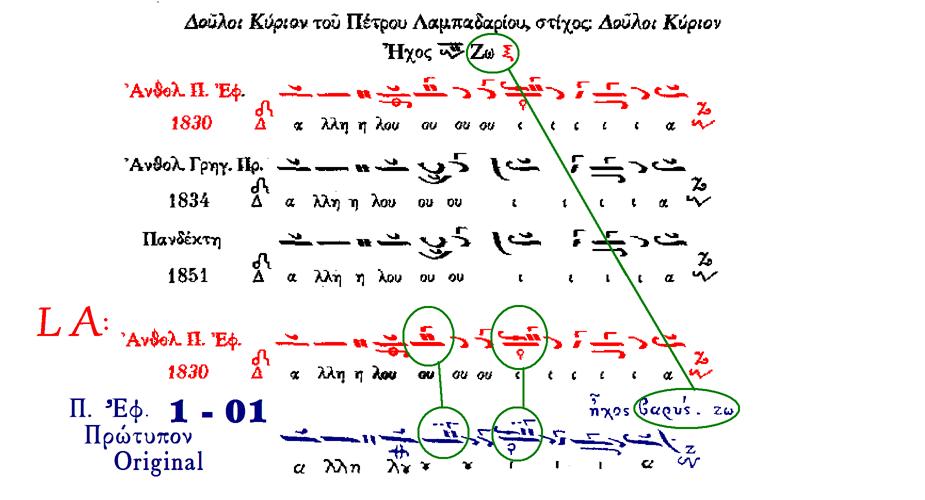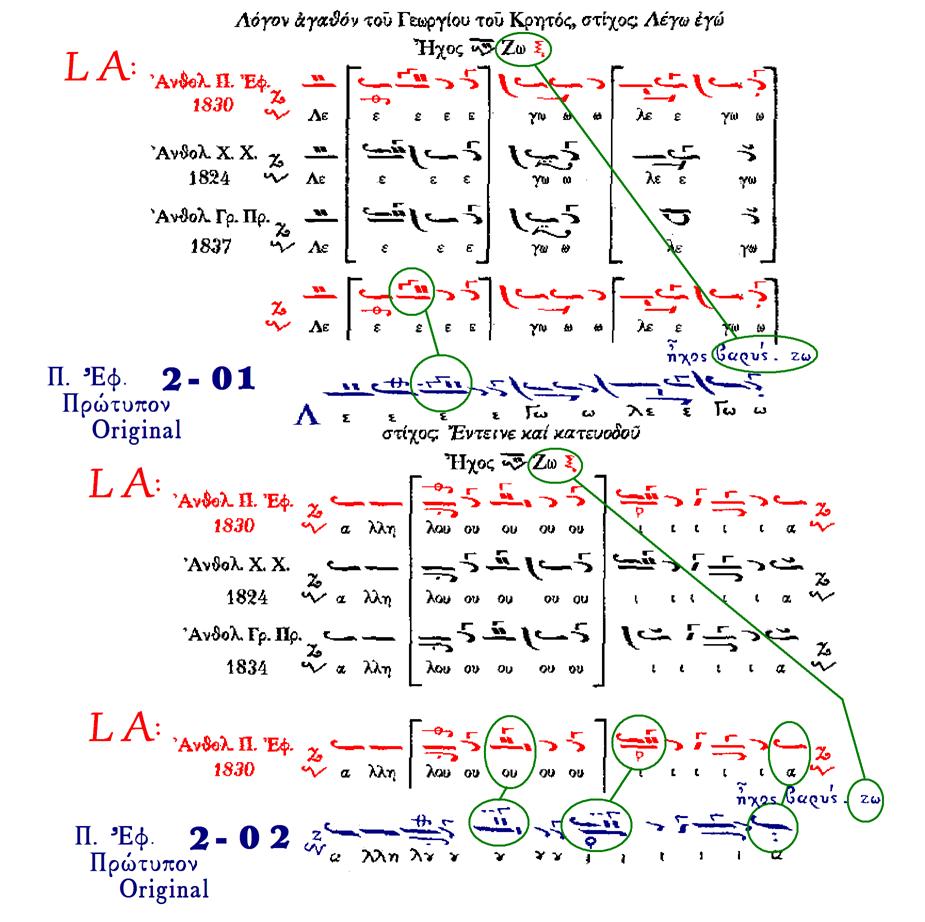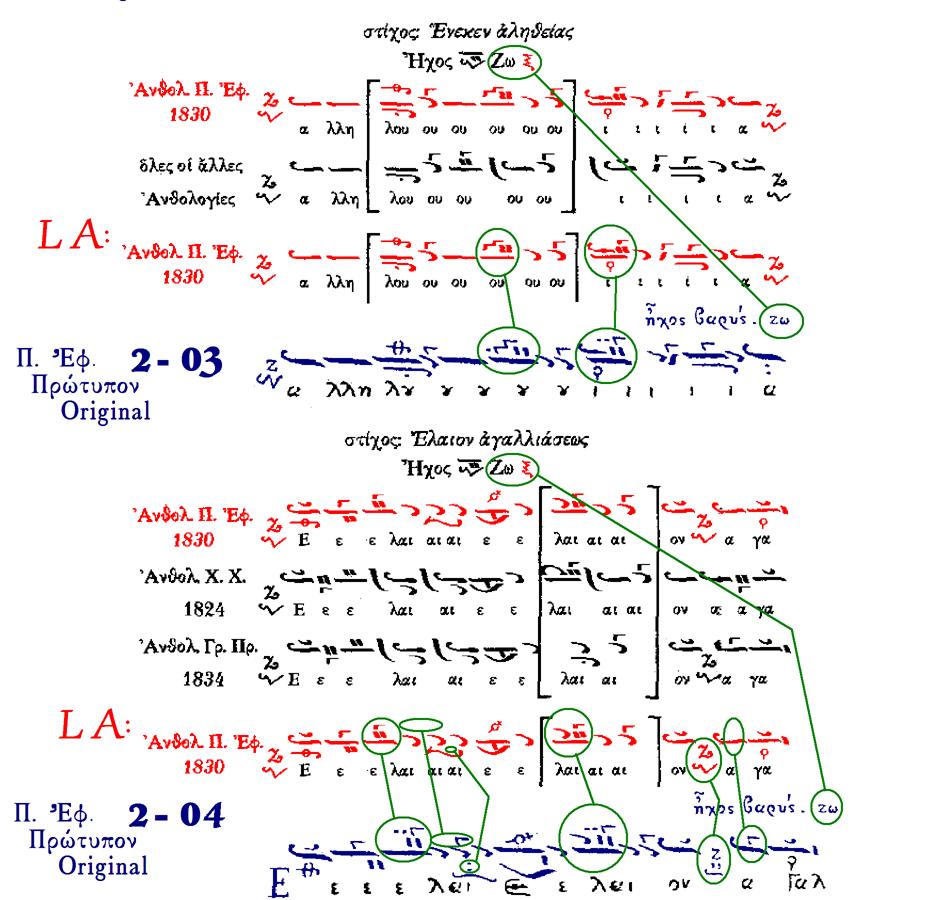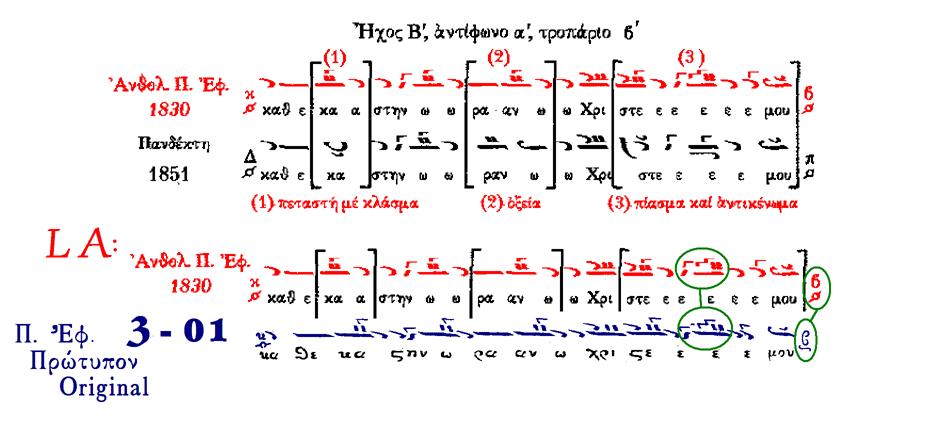|
ΤΙ ΕΣΤΙ ΤΟ |
WHAT IS THE |
|
Ποῦ ὀφείλεται
ἡ ΕΛΛΕΙΨΙΣ
ΠΑΡΑΔΟΣΙΑΚΩΝ
ΠΑΡΕΣΤΙΓΜΕΝΩΝ
ἐν τῇ #ἀντι#γραφῇ, == ΑΡΧΗ
ΕΡΩΤΗΣΕΩΝ ΤΙ ΕΣΤΙ ΤΟ |
Why is there a LACK of TRADITIONAL UNEQUAL temporal DIVISIONS == Question PRIMER WHAT IS THE |
|
Ἡ μονάδα
χρόνου ἐν τῇ
ψαλτικῇ ἀντιπροσωπεύεται
παρὰ ἑνὸς ἀδιαιρέτου
ἀλλὰ καὶ μὴ αὐξημένου
ἴσου . |
The UNIT OF TIME used in psaltiki
is represented by an UNDIVIDED and UNAUGMENTED ISON |
|
|
|
|
|
This is usually transcribed as a QUARTER note in Occidental music. The fractions presented below refer to the
value of such a quarter note. To obtain fraction equivalents for occidental
music notation, one must FURTHER multiply each given fraction by (1/4) |
|
Αὔτη ἡ μονάδα
χρόνου
δύναται ἴνα
ΔΙΑΙΡΕΘΗ κατὰ
τρὸπον |
This unit of time can be DIVIDED in manner that is either |
|
|
|
|
== ἢ ἀσύμμετρον , τουτέστιν ΑΝΙΣΟΧΡΟΝΩΣ,
χάρην εἰς τὴν
ΤΕΛΕΙΑΝ, |
== or asymmetrical, i.e. ANISOCHRONOUS, by making use of a DOT |
|
|
|
|
δημιοργοῦσα ΓΟΡΓΟΝ
μετὰ ΠΑΡΕΣΤΙΓΜΕΝΟΥ |
creating thus a “PUNCTATE” gorgon |
|
π.χ. |
e.g.. |
|
|
|
|
|
|
|
ἢ καὶ |
or |
|
|
|
|
Αἱ διάφοραι ὑποδιαιρέσεις
δύνανται νὰ
προσδιορισθοῦν
διὰ τοῦ ἐξῆς
τύπου, |
The various subdivisions that can be made within a one-unit of time
ISON can be represented by the following mathematical expression: |
|
|
|
|
ὄπου G = Συνολικὸς ἀριθμὸς
γοργῶν D = ἀριθμὸς
τελειῶν εἰς
καθ’ἐκάστην ὑποδιαίρεσιν |
where G = Total number of Gorgons D = number of dots PER subdivision category |
|
Ὁ τύπος οὗτος
προσδιωρίζει (G+1) κατηγορίες, αἱ
ὀποῖαι
δύνανται νὰ εἶναι
ΙΣΟΧΡΟΝΕΣ ἐν ἐλλείψῃ
τελείας, ἢ
ΑΝΙΣΟΧΡΟΝΕΣ ἐν
τυχοῦσᾳ
παρουσίᾳ αὐτῆς. |
This formula defines (G+1) subdivision categories, which can all be
ISOCHRONOUS in the case of no dot addition whatsoever or ANISOCHRONOUS in the
presence of even one dot. |
|
Αἱ τελείαι ἐξ
ΑΡΙΣΤΕΡΩΝ
γοργοῦ τινὸς
συναριθμήζονται
μὲ τὸ ὰντίστοιχον
« n »
τοῦ
γοργοῦ αὐτοῦ, ἐνῷ
αἱ ἐκ ΔΕΞΙΩΝ
συναριθήζονται
μὲ τὸ το
ΠΡΟΣΕΧΕΣ « n », τουτέστη « n+1 » |
Dots placed on the LEFT of a gorgon are considered as being part
of the « n »th subdivision category, |
|
Ἀκολουθοῦν
διάφορα
πρακτικὰ ἢ και
θεωριτηκά
παραδείγματα. |
What follows is a number of practical or even simply theoretical
examples of how psaltic notation division symbols
can be used. |
|
|
|
|
G
= 1, διότι ἕνα καί
μόνον γοργόν, n
= 1 καὶ 2 (G+1 = 1+1 = 2), ἄρα 2
κατηγορίες D1 = 0 (οὐδεμία
τελεία
ΑΡΙΣΤΕΡΑ), D2 = 1 (μία
τελεία ΔΕΞΙΑ), Σ() = 3 = Kατηγορία n
= 1 : (1+D1)/3= (1+0)/3= 1/3 Kατηγορία n
= 2 : (1+D2)/3= (1+2)/3= 2/3 |
G = 1, because there is only ONE gorgon n = 1 and 2 (G+1 = 1+1 = 2) = 2 subdivision categories (groups) D1 = 0 (no dot to the LEFT), D2 = 1 (one dot on the RIGHT), Σ() = 3 = Group n = 1 : (1+D1)/3= (1+0)/3= 1/3 Group n = 2 :
(1+D2)/3= (1+2)/3= 2/3 |
|
Αἱ τελείαι τῶν
παρεστιγμένων
γοργῶν
τίθονται ἐξ
ΑΡΙΣΤΕΡΑΣ
πλευρᾶς. ΜΟΝΟΝ τὸ
ΤΕΛΕΥΤΑΙΟΝ
γοργὸν
δύναται νά
φέρει ΕΠΙΣΗΣ
τελείαν ἐκ ΔΕΞΙΩΝ. Ἐν ΠΑΣΗ
περιπτώσει ὄπου
τὸ ΤΕΛΕΥΤΑΙΟΝ
γοργὸν φέρει
τελεία(ν, ς) ἐκ
ΔΕΞΙΩΝ, (ἀνεξαρτήτως
παρουσίας ἢ ἀπουσίας
εἰς τὴν
ΑΡΙΣΤΕΡΑΝ αὐτοῦ
πλευράν), αὔται
καταλογήζονται
μετά τῆς
τελευταίας
κατηγορίας.
|
Dots of punctate Gorgons are placed on the
LEFT side. Only the FINAL (rightmost, “ending”) gorgon can further bear dots to
its RIGHT. In every case where the RIGHTMOST (final) gorgon bears a dot to its
RIGHT (whether in presence or absence of dots to its LEFT), it is to be
counted as part of the FINAL group.
|
|
|
|
|
G
= 3, διότι τρία
γοργά, n
= 1, 2, 3 καὶ 4 ====(G+1 = 3+1 = 4), ἄρα 4
κατηγορίες D1 = 1 (μία
τελεία
ΑΡΙΣΤΕΡΑ), D2 = 1 (μία
τελεία
ΑΡΙΣΤΕΡΑ), D3 = 1 (μία
τελεία
ΑΡΙΣΤΕΡΑ), D4 = 0 (οὐδεμία
τελεία ΔΕΞΙΑ), Σ() = 7 = Kατηγορία n
= 1 : (1+D1)/7= (1+1)/7= 2/7 Kατηγορία n
= 2 : (1+D2)/7= (1+1)/7= 2/7 Kατηγορία n
= 3 : (1+D3)/7= (1+1)/7= 2/7 Kατηγορία n
= 4 : (1+D4)/7= (1+0)/7= 1/7 |
G = 3, because there are 3 gorgons n = 1, 2, 3 and 4 ====(G+1 = 3+1 = 4), therefore 4 groups D1 = 1 (one dot on the LEFT), D2 = 1 (one dot on the LEFT), D3 = 1 (one dot on the LEFT), D4 = 0 (no dot whatsoever on the RIGHT), Σ() = 7 = Group n = 1 : (1+D1)/7= (1+1)/7= 2/7 Group n = 2 : (1+D2)/7= (1+1)/7= 2/7 Group n = 3 : (1+D3)/7= (1+1)/7= 2/7 Group n = 4 : (1+D4)/7= (1+0)/7= 1/7 |
|
|
|
|
G
= 3, διότι τρία
γοργά, n
= 1, 2, 3 καὶ 4 ==== (διότι G+1 = 3+1 = 4), ἄρα 4
κατηγορίες D1 = 3 (τρεῖς
τελείες
ΑΡΙΣΤΕΡΑ), D2 = 0 (οὐδεμία
τελεία
ΑΡΙΣΤΕΡΑ), D3 = 2 (δύο τελείες
ΑΡΙΣΤΕΡΑ), D4 = 3 (τρεῖς
τελείες ΔΕΞΙΑ), Σ() = 12 = Kατηγορία n
= 1 : (1+D1)/12= (1+3)/12=
4/12 Kατηγορία n
= 2 : (1+D2)/12= (1+0)/12=
1/12 Kατηγορία n
= 3 : (1+D3)/12= (1+2)/12=
3/12 Kατηγορία n
= 4 : (1+D4)/12= (1+3)/12=
4/12 |
G = 3, because there are 3 gorgons, n = 1, 2, 3 and 4 ==== (because G+1 = 3+1 = 4), therefore 4 categories D1 = 3 (three dost on the LEFT), D2 = 0 (no dot whatsoever on the LEFT), D3 = 2 (two dots on the LEFT), D4 = 3 (three dost on the RIGHT), Σ() = 12 = Group n = 1 : (1+D1)/12= (1+3)/12= 4/12 Group n = 2 : (1+D2)/12= (1+0)/12= 1/12 Group n = 3 : (1+D3)/12= (1+2)/12= 3/12 Group n = 4 : (1+D4)/12= (1+3)/12= 4/12 |
|
↓ |
↓ |
|
Τὸ Ἑλληνικὸν
δημῶδες ᾄσμα (π.χ. [1],
[2) δύναται νὰ
διαφέρει τῆς
ψαλτικῆς ὄταν
χρησιμοποιεῖ
ΙΣΟΧΡΟΝΕΣ
διαιρέσεις
ΠΕΡΑΝ τῶν
τεσσάρων ὑποδιαρέσεων
(«κατηγοριῶν»,
δηλαδὴ n>4), τὶς ὀποῖες
χρησιμοποιοῦν
καὶ ἄλλες
παραδόσεις (π.χ. ἐν ταῖς Ἰνδίαις,
συνήθως ἐν τῷ
τέλει τῶν ᾀσμάτων
[1],
[2]). |
The Hellenic traditional FOLK song repertoire (e.g. [1],
[2]) contains a category of songs that differ from the psaltic repertoire in that its songs contain ISOCHRONOUS
divisions within groups of n>4, which can also be found in other
traditions, such as Hindu songs, especially in the song’s conclusion(i.e. [1],
[2]). |
|
|
|
|
Ἐν τῇ ψαλτικῇ
τέχνῃ, ἐπίσης,
σπανίως ὁ
παρανομαστὴς
νὰ περάσει τὸν ἀριθμὸν
6. Οὖτως, λοιπόν, ἐν
τῇ κλασσικῇ
γραφῇ τῆς
ψαλτικῆς, δὲν εἴθηστε
νὰ τοποθετοῦνται
πλείωνα == τῆς 1 τελείας
εἰς
τετράγοργον (n=5) == τῶν 2 τελειῶν
εἰς τρίγοργον (n=4) == τῶν 3 τελειῶν
εἰς δίγοργον (n=3) == τῶν 4 τελειῶν
εἰς γοργόν (n=2) |
It rare in psaltiki that a traditional psaltis will chant temporal divisions where the
denominator is greater than 6 (i.e.24
in occidental music since [1/6]x[1/4]
= [1/24]) Therefore, in the CLASSICAL notation of psaltiki,
there is no need to use more than == 1 dot within a set of four
gorgons (n=5) == 2 dots within a set of three gorgons (n=4) == 3 dots within a set of two gorgons (n=3) ==4 dots within a set of one gorgon (n=2) |
|
Ἀντιθέτως,
τούτον
ΕΠΙΤΡΕΠΕΤΑΙ ἀλλὰ
εἶναι και ἐπιθυμητὸν
εἰς ᾄσματα
τύπου « (ἀ)μανές » ἢ ἄλλων
παρομίων ᾀσμάτων
(π.χ.. [1]). Ἄξιον προσοχῆς ὁ
ΣΕΒΑΣΜΟΣ τῶν ἐλλατομένων
ὑποδιαιρέσεων,
καὶ ἡ
ΔΙΑΦΟΡΟΠΟΙΗΣΙΣ
παρὰ
παραδοσιακῶν ᾀηδῶν
ἀναμεταξὺ ὕμνων
ὲκτὸς (ἄνωθι link) καὶ ἐντὸς ἱεροῦ
χώρου (π. χ.. [2] { προσοχὴ: ἡ
ψαλτικὴ ΔΕΝ
χρήζη τῆς «αὐλομιμήσεως » }) |
To the contrary, this is PERMITTED and is even a PREREQUISITE for correct « (a)manes »
and other interpretations (e.g. [1]). Notice how the traditional Turkish singer
in the preceding link keeps divisions to a MINIMUM when chanting a RELIGIOUS
repertoire (e.g. [2]), from which psaltiki
differs in that it does NOT use “flute imitation” (« αὐλομίμησις »). . |
|
Ὁ ψάλτης ὁ ΜΗ ἔχων
διδαχθῇ
ΠΟΛΥΠΛΟΚΕΣ
ΙΣΟΧΡΟΝΕΣ
διαιρέσεις (ἐφ’ὄσον
ΔΕΝ τοῦ
χρειάζονται ἐν
τῇ ψαλτικῇ),
ΑΣΤΟΧΕΙ ἐν τῇ
προσπάθειά
του ὄπως ἐκτελέσει
αὐτὰς, ὑποδιαιρεῖ
ἐὼς 4
κατηγορίας (ἄκρον
=maximum ἐν τῇ ψαλτικῇ),
προστίθει καὶ
τελείας, καὶ ἀκούγονται
ΠΑΥΣΕΙΣ εἰς τὰς
ἀνόδους καὶ
καθόδους τῆς
φωνῆς,
δίνοντας οὔτως
ἀκουσμα
ΨΑΛΤΙΚΗΣ ἀντὶ
ΔΗΜΩΔΟΥΣ
ΑΣΜΑΤΟΣ (π. χ.
Στανίτσας). |
Any chanter NOT having learned COMPLEX ISOCHRONOUS divisions (given
that they are of no use in traditional psaltiki)
MISSES out upon attempts to interpret such vocalisations, because he will
usually not go beyond 4 groups (= “maximum” in psaltiki),
and will add dots instead, thus giving a sort of “PAUSE” within the melody
and an overall interpretation that resembles more to psaltiki
than to DEMOTIC FOLK song (e.g. this
is what Stanitsas does when singing folk songs). |
|
|
|
|
Τουναντίον, οὐχ
ὀλίγοι #ψάλται#
εἰσήγαγον ΠΟΛΥΠΛΟΚΕΣ
ΙΣΟΧΡΟΝΕΣ (δημοτικο ᾀσματικὲς) (Μηλιώνης, Ἀηδονίδης-Καραντζὴ)
ἢ καὶ
ΠΟΛΥΠΛΟΚΕΣ
ΑΝΙΣΟΧΡΟΝΕΣ ([α]μανο-ᾀσματικὲς) ὑποδιαιρέσεις
(π. χ. Στανίτσας) ἐν δημοσίοις
παραστάσεις -
#συναυλίας# (concert) ἤ
καὶ ἐν τοῖς ἱεροῖς
ναοῖς. |
In contrast, not so few are the “psaltis”
who have introduced
COMPLEX ISOCHRONOUS (“demotiko-asmatic”)
(Μηλιώνης,
Ἀηδονίδης-Καραντζὴ)
or even COMPLEX ANISOCHRONOUS ([a]mano-asmatic) subdivisions (e.g. Stanitsas) in public presentations,
concerts or even within the holy churches. |
|
Τὰ ἐλατώματα
αὐτὰ ἀποκαθιστοῦν
ΛΑΝΘΑΣΜΕΝΗΝ
χρῆσιν
ΠΑΡΑΔΟΣΙΑΚΩΝ
λαρυγγισμῶν. |
Such “habits” have become the source of a MISADAPTED and, by consequence, |
|
|
|
|
Χάριν εἰς τὸν #ΜΗ ΓΝΩΡΙΖΟΝ#,
κατὰ τὸν Ἰάκωβον
Ναυπλιώτην, τὴν
μουσικὴν ἡμῶν,
|
Thanks to him who, according to Iakovos
NAFPLIOTIS, #IS NOT ACQUAINTED# with OUR music, |
|
Ἀναφορικῶς, ὄσον
ἀφορᾶ τὰ διαστηματικὰ
φάλτσα, πρὸκειτε
περὶ ==χρήσεως ΔΥΤΙΚΟΥ
τόνου 200 cents, χάριν
εἰς τὴν ΚΑΤΑ
ΓΡΑΜΜΑ (καὶ οὐχὶ
ΚΑΤΑ
ΠΑΡΑΔΟΣΙΝ) ἑρμηνεία
τῆς ΔΥΤΙΚΟ
ΕΠΗΡΕΑΣΜΕΝΗΣ
ΕΠΙΤΡΟΠΗΣ του
1881, (Κείμενον),
(1),
(ἠχητικὸ
παράδειγμα) == ΑΠΟΡΡΗΨΙΣ τῆς ΧΡΥΣΑΝΘΙΚΗΣ
ΔΙΦΩΝΙΑΣ == ΕΙΣΗΓΗΣΙΝ
ΔΥΤΙΚΗΠΡΕΠΟΥΣ
== ΕΙΣΗΓΗΣΙΝ ΕΛΑΤΩΣΙΣ
ἐν τῷ ἀριθμῷ τῶν
ΑΝΑΛΥΣΕΩΝ, |
In passing, one may simply quote the various interval or diastematic FALTSOS,
which are ==the use of an OCCIDENTAL tone
of 200 cents, thanks to a LITERAL (and not a TRADITIONAL O/AURAL) interpretation
of the results published by the OCCIDENTAL influenced Committee of 1881 (Text),
(1),
(audio
samples) ==the REJECTION of the CHRYSANTHIC DIPHONIC third ==the INTRODUCTION of a OCCIDENTAL-like ==the introduction of a REDUCED
number of DEVELOPMENTS
(“analysis”), |
|
|
|
|
Ἐπειδὴ τὸ
θέμα ἀφορᾶ τὰς
δαιρέσεις
χρόνου, == ΑΠΛΩΝ ΙΣΟΧΡΟΝΩΝ
ὺποδιαρέσεων,
λόγου, ἐπίσης, ΚΑΤΑ
ΓΡΑΜΜΑ ἐκτελέσεως
ΝΕΑΣ ΟΣΟ διὰ τὴν ΕΠΙΜΟΝΟΝ
παρὰ τῷ Πέτρῳ Ἐφεσσίῳ
ΚΑΤΑΓΡΑΦΗΝ |
Since the present topic concerns
TEMPORAL DIVISIONS, == SIMPLE ISOCHRONOUS
subdivisions, based upon, once again, the LITERARY interpretation of the NEW The various lines chosen are not
so much to be considered as “important #elements# for research” ( #σπουδαῖα τεκμήρεια στὴν ἔρευνα#) which is PROOF
enough |
|
|
|
|
|
|
|
|
|
|
Ὡσὰν νὰ μὴ ἐπαρκοῦν
τὰ ΑΚΟΥΣΤΙΚΑ
δείγματα, Ὄστις θέλει ἴνα
ΕΞΑΣΚΗΣΕΙ τὴν
ΟΠΤΙΚΗΝ αὐτοῦ
αἴσθησιν |
As if the audio samples (listen to examples provided below) were not
sufficient, Whoever might wish to EXERCISE one’s OPTICAL perception capacities |
|
|
|
|
|
|
|
|
|
|
|
|
|
|
|
|
|
|
|
Ἰδοὺ ἐνδεικτυκῶς
καὶ ἡ
#πιστότης# τῆς
#αντι#γραφῆς |
Solution : check the “specialist’s” “copying fidelity” |
|
|
|
|
|
|
|
|
|
|
|
|
|
|
|
|
|
|
|
Διακρίνει τις == τήν ΧΡΗΣΙΝ φθορᾱς
ΛΕΓΕΤΟΥ εἰς τὸν
Ζω τοῦ
ΒΑΡΕΩΣ ἦχου (ἡ ὀποῖα ΔΕΝ ὑπάρχει
εἰς τὰ αὐτούσια
κείμενα) == καὶ
τήν ΣΥΣΤΗΜΑΤΙΚΗΝ
ἀπόρρηψιν
ΠΑΡΕΣΤΙΓΜΕΝΩΝ! == ὡς καὶ
διάφορα
#τυποργραφικὰ#
λάθη, |
One can distinguish == the USE of the modulating sign (#fthora#)
of #LEGETOS = BOU# on the Ζω of the #Barys
diatonic# mode (which DOES NOT exist as such
in ANY of the quoted material) == the SYSTEMATIC
removal of unequal division signs (punctate [dotted] gorgons)! == as well as a number of other #typographical# errors, |
|
|
|
|
Ἐφοδιαμένος
πλέον ὁ ἀναγνώστης
μὲ τὰ
μαθηματικὰ καῖ
γραφικὰ
παραδείγματα |
The reader, now armed with mathematical as well as graphical examples
of |
|
ΤΙ ΕΣΤΙ ΤΟ |
WHAT IS THE |
|
Ὀρισμός: |
Definition: |
|
Τὸ ΕΝΔΟ - ΙΛΑΡΟΧΟΡΕΥΤΙΚΟ
–
ΣΙΜΩΝΟΚΑΡΑΔΟΦΩΝΟΝ ΑΝΑΠΡΟΣΑΡΜΟΣΤΟΣ
ΠΑΥΣΙΣ (ΠΑΡΕΣΤΙΓΜΕΝΟΝ !) εἰς γοργὸν
ἐντὸς
μονάδως
χρόνου περικυκλωμένης
παρὰ ἄλλων, ΑΠΛΟ -
ΙΣΟΧΡΟΝΙΚΩΣ
διηρημένων
μονάδων, ἡ ὀποῖα
δημιουργεῖ ΑΚΟΥΣΤΙΚΗΝ
ῬΥΘΜΙΚΗΝ διατάραξην
τε
καὶ |
The “ENDO - HILAROCHOREUTIC SIMONOKARADOPHON” UNADAPTED PAUSE (obtained by the use of at a within a unit of time that creates an ACOUSTIC RHYTHIC PERTURBATION and IMBALANCE |
|
|
|
|
|
|
|
|
|
|
ἠχητικὰ
παραδείγματα |
audio samples |
|
Σύγγρισης = #ἀπολαύσατε#
κατ’ἐπανάληψιν |
Compare = #enjoy# the REPETITIVE |
|
(Thras Stan - Canonarch – GKM -
LA) |
|
|
Ἐν συνεχείᾳ,
παραχωρούνται
ἠχητικὰ ἀποσπάσματα |
In the following audio samples excerpts, |
|
|
|
|
Ἰδοὺ καὶ ὁ
#δημιουργὸς#
τοῦ ΕΝΔΟ - ΙΛΑΡΟΧΟΡΕΥΤΙΚΟ
– ΣΙΜΩΝΟΚΑΡΑΔΟΦΩΝΟΥ |
Finally, here is the “INVENTOR” of the
”ENDO –
HILARO –CHROREUTIC SIMONOKARADOPHONONS” |
|
(solo
excerpts from the Acathist Hymn Ἀκαθίστος
Ὕμνος) |
|
|
|
|
|
Οἱ τρεῖς ἑρμηνευτὲς
παρουσιάζουν ΤΡΟΜΕΡΑΝ
ΑΣΤΑΘΕΙΑΝ
ΔΙΑΣΤΗΜΑΤΩΝ, ἰδιαιτέρως
εἰς τὰς
καταλήξεις,
διότι ΔΕΝ
παιρνοῦν #ἀπὸ
κάτω#, ὀπως οἱ
παραδοσιακοὶ
ψάλτες. Παραδόξως, ὁ Καρὰς
ΔΕΝ κάμνει πολλοὺς
φάλτσο
λαρυγγισμούς
εὶς τὶς παλαιὲς
ἠχογραφήσεις (Melpo Merlier,
ἄνωθεν) Ἐν συγγρίσει
μὲ τοὺς
μαθητές του, εἶναι
πιὸ
#παραδοσιακὸς#,
καὶ
καταλαβαίνω
διατὶ μερικοὶ, #ἀσπάσθησαν
Σιμωνοκαραϊτισμόν#. |
The three performers from the Simon Karas
school of “thought” present with SEVERE
INTERVAL INSTABILITIES, especially as concerns CONCLUDING cadences (#καταλήξεις#),
because they simply haven’t learned how to “stabilise” such notes from
“below”, as do ALL the traditional psaltis before
the Simon Karas “era”. One should be honest, however, and admit that, In CONTRAST, he DOES perform a CORRECT
anticipation of CONSONANTS and adds a TRADITIONAL INITIAL #glissando”
[NOT concluding] of the type seen within Gregorian chant palaeography (« pes»), As compared to his “students” or “followers”, he is MUCH MORE …. #TRADITIONAL#,
and one can “understand” why some of them, #converted” to “Simonokaraïticism#. |
|
|
|
|
Εἰς τὸ μέλον θὰ
παραχωρηθῇ καὶ
φασματογραφικὴ
ἀνάλυσις πρὸς
εὐκολοτέραν
κατανὸησιν αὐτῶν
τῶν ΝΕΟΦΑΝΩΝ
ψαλτοπαθειῶν. |
In the future, this webpage will provide a SPECTRAL ANALYSIS of the above examples as well as other audio
excerpts, so that these |
|
|
|
|
Τέλος, ὰπὸ τὴν
στιγμὴν ὄπου ἀποδεικνύεται
ὄτι διερωτεῖτε
τις: |
Finally, given that there is sufficient proof that |
|
|
|
|
Ἡ ἀλλοίωσις τῶν ΠΑΡΕΣΤΙΓΜΕΝΩΝ
γοργῶν καὶ ἡ ἀντικατάστασίς
τους παρὰ ΙΣΟΧΡΟΝΩΝ
διαιρέσεων (φωνητικῆς ἰδιομορφείας) ἢ μήπως εἶναι
θέμα ΣΧΟΛΗΣ (σχολικῆς ἰδιοσυγγρασίας); |
Are changes of PUNCTATE gorgons and their replacement
by ISOCHRONOUS
divisions or rather a matter of SCHOOL’s |
|
|
|
|
Παρόμοιον ἄρθρον |
Similar article (bilingual) |
|
« Συγκίνησις =
ΑΥΤΟΜΑΤΟΣ
μετάφρασις » [html] |
« Synkinesis » [English Text] |
|
|
|
|
Ἱλαροχορευτικὲς χορωδίες [html] |
Hilaro-choreutic choirs
[html] |
|
|
|
|
|
|












